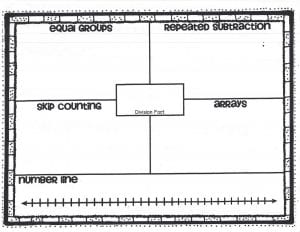by C. Elkins, OK Math and Reading Lady÷
In my opinion, the process of repeated subtraction is very important for students to practice. With repeated subtraction, we are actually asking this question: “How many _____ in _______?” If the problem was 20÷4, we can ask, “How many 4’s are in 20?” The process is to keep subtracting 4 (using concrete, pictorial, and abstract methods) until zero is reached. This would be done 5 times — thus, 20 ÷ 4 = 5.
Much like multiplication, there are different aspects of division children should become familiar with.
- Arrays
- Equal Groups
- Repeated Subtraction
- Number lines
- Skip counting
The focus today will be to help children understand how repeated subtraction can assist with the division process (using manipulatives, drawings, and paper-pencil methods). The template pictured here is FREE from: Multip. and Division templates FREE from Number Two Pencils @ TpT
The reason the repeated subtraction strategy is important is because this is what we are really asking students to do when they encounter long division or partial quotient problems. With the problem 100 ÷ 4, the question is, “How many 4’s are in 100?” If the repeated subtraction process is used, the answer is of course, 25. But subtracting 4 twenty-five times is not very efficient. So we want the student to get closer to 100 and subtract larger amounts than 4 at a time. The partial quotients method would allow the student to do this in chunks. 1 solution could be to subtract 40 (ten 4’s), subtract another 40 (ten more 4’s), subtract 20 (five 4’s). See picture below: Continue reading



